It’s the bold Golden Wattle (or Acacia Pycnantha) that perhaps represents the spirit of Australia, unlike any other plant. Its bright gold and green have become our national colours. We’ve written songs and poems about it. Its flowers are in the Commonwealth Coat of Arms – we even celebrate National Wattle Day every year.
But most of all, for many Australians, the Wattle tree symbolises home and kindred. The Aussie grit, a memory of childhood bush walks, sunshine and the arrival of spring.
So let’s talk about the Australian Wattle! If you are keen to get the lowdown on this national icon and want to know what makes it so special, how to grow it and what its uses are, then we invite you to read on.
All we can say at this point is that there’s more to the Wattle than meets the eye!
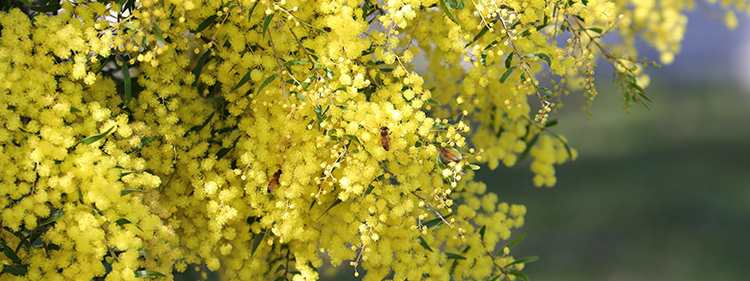
The Australian Wattle – Our National Treasure
“This land we call Australia, is home sweet home to me,
Wherever I may wander, sweet is the memory
Of silver sands, the ocean roar, tall trees and wide, sparse plains,
But of all the lasting images, it’s wattle blooms after rain”
(verse from “Wattle Blooms After Rain”, a poem by Joy Warnes, WA)
The Wattle is such a trouper, able to withstand the Australien winds, bushfires and droughts, only to emerge after every winter in the most glorious colours and garlands of shiny gold and lush green.
So it’s easy to see why the Wattle was chosen as the Australian Floral Emblem, has adorned our stamps and is being used in the Australian honours system.
On national days of mourning, a sprig of wattle is often worn as a symbol of reflection and unity. Its single flower represents the Order of Australia.
These days, you can recognise any Australian national and Olympic sports team from a mile away, wearing green and gold uniforms- the Golden Wattle colours.
A little bit of Australian Wattle History
Did you know that the Golden Wattle has been blooming in Australia for the past 35 million years? Talk about resilience!
A recent study showed that well over 50,000 years ago, First Nation Peoples of Western Australia lit campfires with the wood of various wattle species endemic to Australia. Not only that, the Wattle’s sap, pollen and wood were transformed into tools, musical instruments, medicine, dyes and glues, and even perfumes.
Back then, the bloom of the wattle flowers also heralded springtime, eels arriving in streams and whales along the coast.
Fast forward to the 18th century and the arrival of European settlers. It took them quite some time to appreciate and classify the many Wattle species native to Australia. But, they also gave it its common name! ‘Wattle’ is an old Anglo-Saxon word referring to a construction technique for houses, weaving small branches and twigs to form a building’s framework.
By the early 1900s, after the formation of the Commonwealth of Australia, Wattle flowers started to symbolise Australian unity and identity. During World War I, sprigs of Wattle and badges were sold to raise money for the war, and pressed flowers were sent to soldiers wounded throughout Europe.
And would you know it, in 2020, Golden Wattle seeds were launched into space in Operation “What’ll happen to the Wattle”
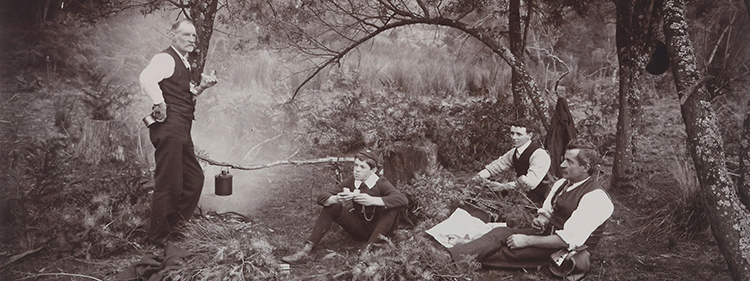
The Botanists’ Wattle
Is it a Wattle? Is it an Acacia? And what about Mimosas?
Well, Wattles belong to the genus Acacia, which in turn belongs to the pea family (Fabaceae). In fact, what we call the Australian Wattle Tree is actually called Acacia Pycnantha.
Mimosas also belong to the pea or legume family. They are sometimes hard to tell apart from Acacias – both have fern-like foliage and showy flowers. Mimosas hail mostly from China, whereas Wattles are largely Aussie homegrown.
But the Golden Wattle is certainly not the only species! In fact, there are over 1300 known and classified Wattle species, most of which can only be found in Australia. But although most are endemic to Australia, you can find them right around the globe, from the Pacific region to the Mediterranean and throughout Asia, Africa and the Americas.
Australian wattles are easy to grow. They can grow from seed. Once they’ve found their spot, they usually take off at speed, growing quite rapidly. therefore making them the perfect quick pick-me-up and a useful screening plant.
There are many different kinds of native Wattles, from ground cover to dwarf plants and shrub-sized plants to the impressively tall Golden Wattle that can reach heights of 10 metres. Although all are incredibly forgiving of neglect, varying temperatures or poor soil, they generally don’t do well in heavy frosts or poorly draining soil.
Because Wattles grow fast, they make excellent hedging and windbreakers. Not only that, you’ll get their blooms’ lovely scent in springtime, and the trees will attract seed-eating birds to your garden.
In fact, speaking of birds! The lovely Wattlebird is actually not named after our Wattle at all. Wattlebirds are honeyeaters; you might find them more commonly in gum- or bottlebrush trees.
Wattle it be?
Which wattle will grow well in your backyard? Which one will you see on bush walks or hiking in the mountains? In fact, perhaps are you looking for a compact wattle bush for your patio?
So with that said, here are some of our all-time favourite Aussie Wattles.

The Golden Wattle
The most recognisable golden lady of the Australian landscape, is native to South Australia and Victoria and does best in temperate climate zones. In fact, the tree can get up to 10 metres tall and 6 metres wide.
You could say the Golden wattle likes life in the fast lane: it grows incredibly fast but has a relatively short life expectancy, often only around ten years. The Golden Wattle is an evergreen but will gift you with clouds of beautifully scented, golden flowers every spring!
This is not a fussy plant and will adapt to most conditions. It likes well-draining, sandy, loamy soil, is drought tolerant and does well in sun to light shade. However, it does well in warm and cool temperate climates and away from frosts.
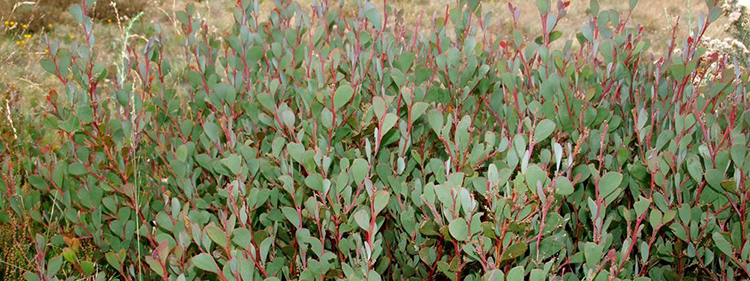
The Alpine Wattle
Most of the wattle species thrive in dry, arid climates and subtropical regions, so we thought it is well worth highlighting one of the two species that have bucked the trend. You’ll find the Alpine Wattle in parts of the Australian Alps at altitudes of 1,300 m to 1,800 m, specifically from Lake Mountain to the Snowy Mountains and in alpine pockets in the south of the Australian Capital Territory.
The Alpine Wattle is more of a shrub, growing up to 2 m in height. Additionally, it flowers from October to November. In gardening, you can use it as ground cover. It can survive strong winds and months covered in a blanket of snow.

The Black Wattle
The Black Wattle is usually a little bit overlooked, so we thought it was about time to highlight its place in the plant world and the natural food chain.
Did you know that its bark with all its cracks is home to many insects, including the rare Tasmanian Hair Streak Butterfly, which lays its egg in these crevices? Hornbills love the insects they can find under its bark, and black cockatoos thrive on the grubs in Black Wattle. Underground, fungus roots will attach themselves to the tree’s extensive root system and produce truffles that bandicoots, potoroos, and bettongs just can’t resist. And after such a truffle feast, marsupial droppings will spread spores far and wide and continue this circle of life.
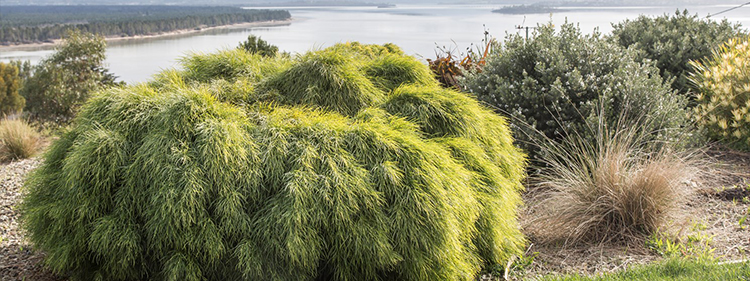
Acacia Limelight
Well, the name says it all. It’s a pocket rocket of a plant that will add the ‘wow’ to your garden. It’s compact, can grow well on a balcony, can be used as ground cover and can be equally formidable in a border planting. Like the many native species, Acacia Limelight is a low-maintenance delight. As long as you keep it reasonably sheltered, out of frosts and give it a little fertiliser in its growing phase, you will have a happy plant.
For more details on this wattle species, head over to this comprehensive guide.
What grows where?
If you want to find out which Wattle tree will grow best in your area, check out this complete guide from Better Homes And Garden. They’ve also included some general growing, caring and maintenance tips and added helpful video links.
The many uses of the Australian Wattle Tree
There’s hardly a part of the Wattle tree that can’t be used in some form or other! Tens of thousands of years ago, the tree was already a pharmacy, a grocer and a supplier of raw materials to our First Nations Peoples – and still is to this day.
Did you know that:
- A third of all Australian wattle species start flowering in Winter – but the Golden Wattle, our national flower, puts on its show a bit later, signalling the beginning of spring.
- The wattle is commercially grown for its cut flowers in some parts of the world.
- The flowers are a treasured symbol of the carnival in Basel, Switzerland, for example. And in Italy, a sprig of mimosa or silver wattle is given to women at the Festa Della Donna – International Women’s Day.
- Tannin is used for leather tanning or in fabric dyes.
- Its wood is used for firewood and woodwork.
- Some wattles also excrete gum.
- Acacia ligulata is rumoured to cause hair loss.
- The beautifully scented wattle flowers are used in honey production and also in perfumes.
- Wattle seeds are considered Australian bush tucker. But you can use edible wattle seeds* for a ton of yummy recipes! Have you ever tried wattle seed bread, pancakes or wattle flavoured ice cream?
- Wattle seeds have a high nutritional value, with high levels of calcium, zinc, iron and potassium – AND they are an excellent food source for people with diabetes.
- The young roots of the Wattle tree can be roasted and used as a food source.
- Some Wattle species can be used to treat headaches, rheumatism and general aches and pains, colds and toothaches.
- There’s even a Facebook page dedicated to Black Wattle furniture.
- One of the most recognisable and well-known Australian portraits is perhaps that of the young Queen Elizabeth II in 1954, wearing a beautiful gown embroidered with sprigs of wattle.
- It even earns a mention in the Australian cricket team’s victory song: “Under the Southern Cross I stand, a sprig of wattle in my hand, a native of my native land, Australia, you f***ing beauty!”.
- Every springtime, 15% of Australians will suffer from hay fever – and many times, the wattle gets all the blame for these allergic reactions. According to research studies, though, this is an unfair accusation. Allergy tests rarely confirm that it’s the wattle and its spring pollen that causes hay fever.
*) Please note: It is believed that only between 20 to 50 species of all the native wattles produce edible seeds. Some can only be fed to livestock; others are toxic to both humans and animals.
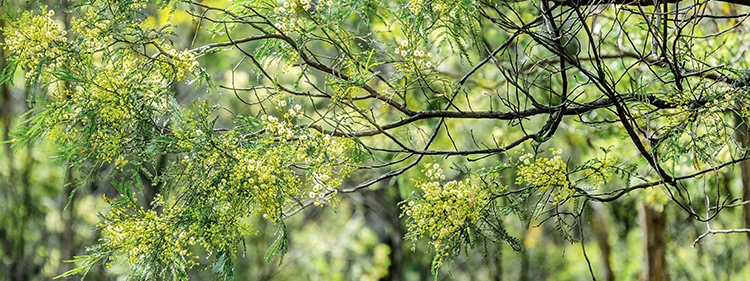
So before you go foraging, it is essential that you know which wattle seeds are edible! Cooks Info lists the top varieties to produce edible seeds as
- Acacia victoriae (aka “Gundabluey”),
- Acacia murrayana,
- Acacia mulga,
- Acacia colei,
- Acacia longifolia,
- Acacia notabilis,
- Acacia retinodes,
- Acacia pycnantha,
- Acacia fimbriata, and
- Acacia difficilis
Adding a sprig of Wattle to your home decor
We found hundreds and hundreds of Wattle ideas on Pinterest. No surprises there, really! Who wouldn’t want that instant pick-me-up in a vase, that little pop of colour that will bring spring to you inside?
Let the wattle do all the talking. Perhaps you are organising the first BBQ of the season or a festive afternoon tea? Why not add some simple sprigs of wattle to mason jars interspersed with fairy lights? It’ll look stunning.
Most wattle blooms are also relatively easy to dry and look stunning paired with other Australian natives, such as eucalyptus branches and bold Banksia.
Because the wattle blooms grow on a bush or tree, they already have relatively sturdy twigs and branches to support them. The flowers can be air-dried in a vase or hung upside down. Just make sure you get rid of the bottom leaves on your stems and leave them to dry in a well-ventilated but not windy, and a dark spot.
Check out these lovely wattle-inspired ideas. Some super cool jewellery, trendy home decor, even the most eye-catching cake and mouth-watering yummy wattle seed recipes
National Wattle Day
We couldn’t leave you without giving the 1st of September, National Wattle Day, an honourable mention!
Wattle Day was first celebrated in 1838 but wasn’t formally recognised as Australian Wattle day until 1992. So this year, the 1st of September marked Australian Wattle Day, the beginning of spring and 30 years since it’s been officially recognised!
But did that stop us from celebrating it? Of course not! Although the Wattle got a little bit lost and forgotten in the mid-1900s, Wattle Day festivities have been held across the country ever since that first celebration in 1838 in Hobart.
Traditionally Australians wear a sprig of wattle, plant a Wattle tree and decorate the streets with wattle blossoms. Just have a look at some of the ways Australians were encouraged to celebrate the most recent Wattle Day:
- “Wear a sprig of wattle or something bright yellow
- Organise a picnic, lunch, BBQ under a wattle tree with your family and friends
- Plant a wattle in your garden or a grove
- Go for a walk in your suburb, nearby bush or arboretum and enjoy the wattles in bloom
- Encourage your local markets to have a wattle theme in the lead-up to National Wattle Day
- Support your local school to celebrate the day.
- Ask your local council to light up landmarks in yellow and green on the day.
- Sing a wattle song with the children in your life.”

Final thoughts
We’ve been amazed by all the weird and wonderful facts we’ve unearthed about the Australian Wattle Tree – or should we say about all the many amazing Australian Wattle Trees?
When it comes to our national flower, there can only be one: The Golden Wattle, the Acacia Pycnantha.
But it’s the sum of all the many species that come to life in Australia every winter, ringing in spring in all its glory – that is perhaps what we most identify with.
All those Wattle trees that are usually the first ones out of the ground after a bush fire. The ones that shine bright in the sunshine – and leave a golden blanket underneath their branches after heavy rain, they’re the ones to leave a mark in our memories.
What does the Wattle tree mean to you? Does it have a spot in your heart – In your garden? Does it evoke childhood memories? Do you seek it out when overseas? Do you know the best nurseries to get a native wattle?
Or do you have a crafty wattle DIY idea or a yummy recipe you are happy to share?
We’d love to hear from you!
Like it? Share it.

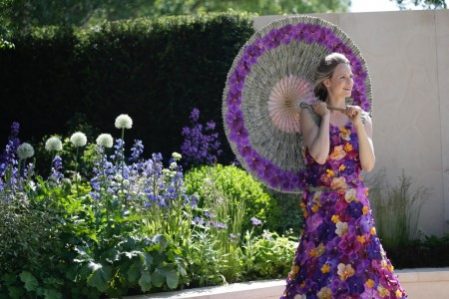
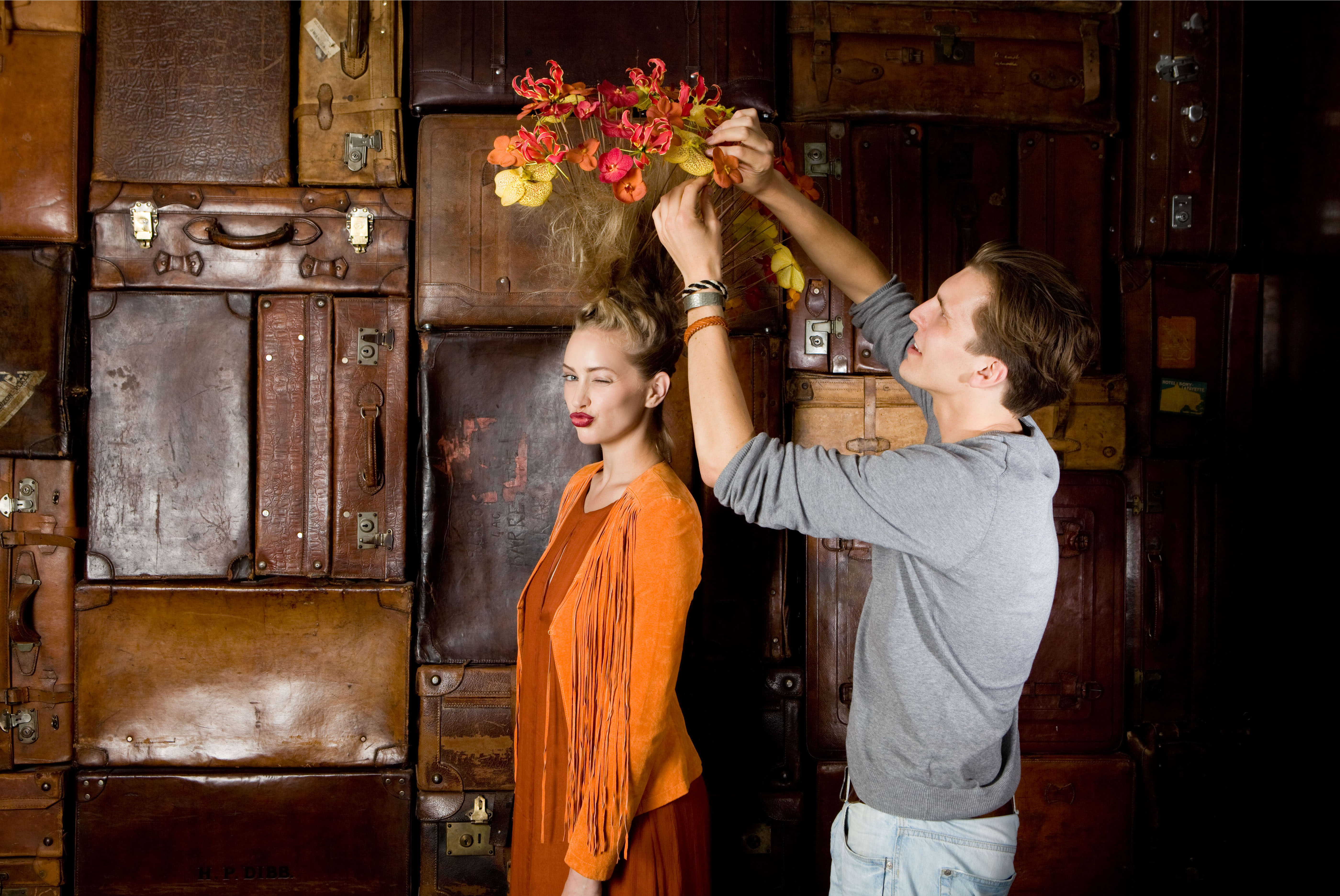

No Comments